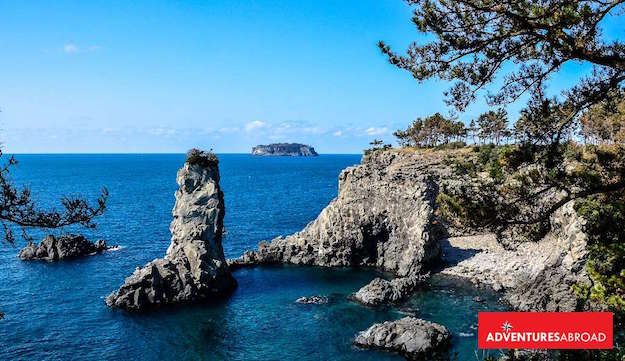Our South Korea tours typically start in Seoul, a modern metropolis that has spilled over its 600-year-old city walls and grown to a population of 25 million. Its residents are part of a progressive Asian culture with deep respect for its past and traditions.
 The beautiful Jeju Island is one of South Korea’s most popular vacation spots, whether for simple vacations or for honeymooners. It is home to a dormant volcano (South Korea’s tallest mountain) and the world’s longest lava tube (Manjang Cave).
The beautiful Jeju Island is one of South Korea’s most popular vacation spots, whether for simple vacations or for honeymooners. It is home to a dormant volcano (South Korea’s tallest mountain) and the world’s longest lava tube (Manjang Cave).
Illustrating the juxtaposition of past and present is Gyeongbokgung Palace, the Joseon Dynasty’s sprawling residence, which had been the seat of Korea’s government for almost 500 years. Now, the tranquil setting of the Palace is set against Seoul’s tall skyline and frenetic pace.
Despite the huge size and population of Seoul, one can escape the metropolis to Seoraksan National Park, home to Mount Seorak, where an aerial tram gives visitors access to one of its towering peaks, giving them a panoramic view of the stately mountain. The park is full of mysterious temples, hiking trails, deep forest, beautiful waterfalls and remote hermitages.
South Korea tours reveal a variety of Buddhist temples, such as Haeinsa Temple, considered by many to be its pre-eminent Buddhist treasure. Inside it contains a huge collection of Buddhist scriptures, known as the Tripikata Koreana, spread across nearly 80,000 wooden pieces, dating back to the 13th century.
Another important Buddhist temple to visit is the Bulguksa Temple in Gyeongju. This city is practically an open-air museum that, more than any other city in South Korea, is full of history, sanctuaries, temples, pagodas and tombs. The city’s ancient wealth is quickly apparent in the city that was the head of the Shilla Dynasty, dating back as far as 57 BC, to 935 AD.
While the Shilla Dynasty occupied the entire Korean Peninsula, our South Korea tours stop at the demilitarized zone (DMZ) between South and North Korea. This area contains many sites of interest, including the Freedom Bridge where, in 1953, nearly 13,000 Koreans walked to freedom; Dorasan, the historic railway station, is still marked for travel between Seoul and Pyeongyang; at the Dora Observatory one can see the broad expanse of the DMZ, including Gijeong-dong, North Korea’s propaganda village.
Busan is one of South Korea’s important cities and, luckily, escaped without any fighting taking place there during the Korean War in the 1950s. The Gamcheon Cultural Village, once considered a slum, now has the nickname of the ‘Santorini of the East,” and its colourful, low-rise housing crowds its narrow streets climb and twist through the mountainous part of the city.
Foodies will enjoy South Korea, where the food is distinct from surrounding countries, with great variety, spiciness and flavour. Being next to the sea, South Korean fish markets such as Jagalchi Fish Market and Kukje Market source every sort of fish you can imagine, and more.
Check out our South Korea tours to learn more about this fascinating country.